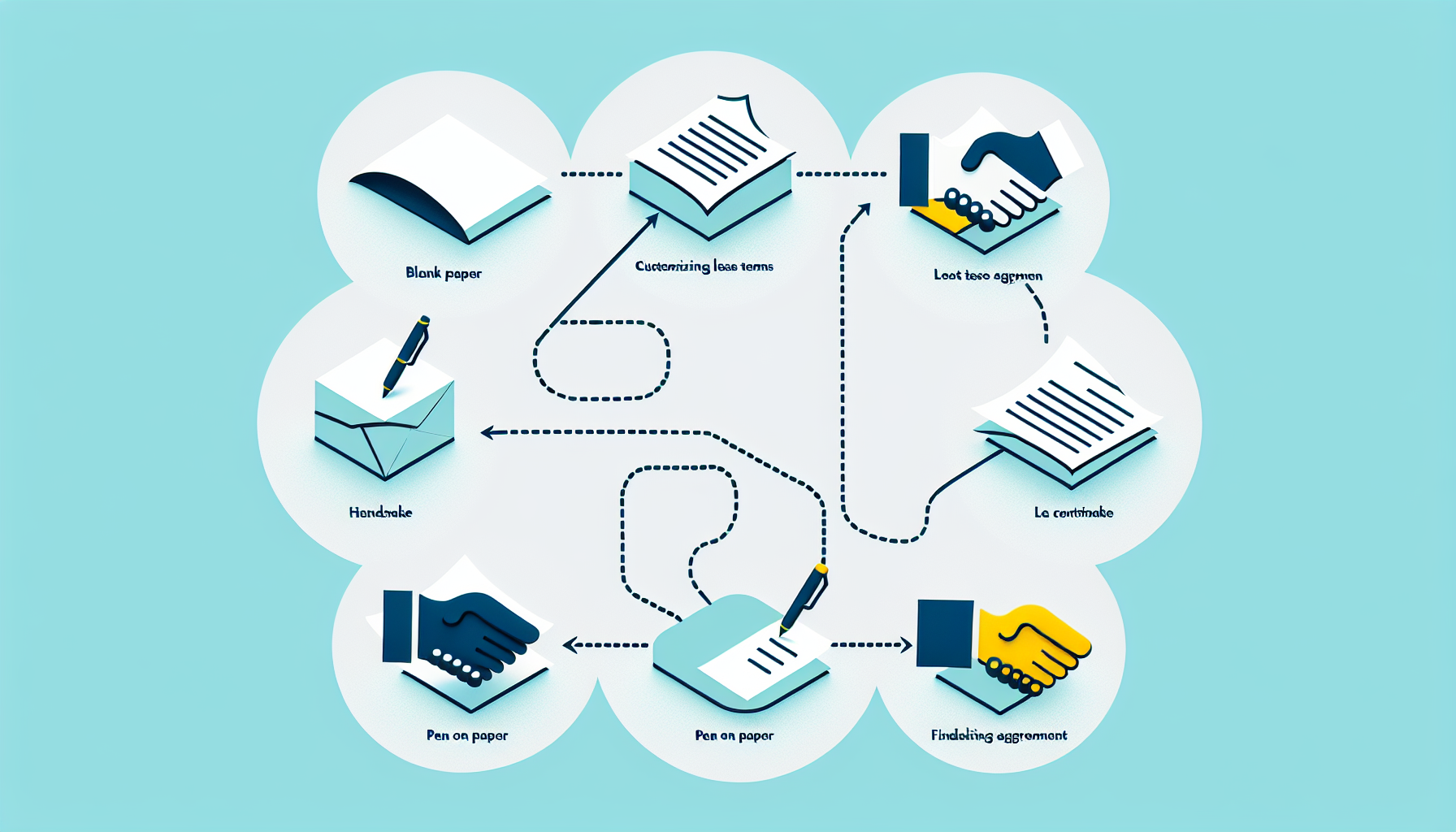Need a business lease agreement template? This article delivers straightforward, legally sound templates in PDF and Word formats. Ensure your commercial lease safeguards your interests with a no-nonsense template fit for a variety of properties.
Key Takeaways
- A commercial lease agreement is a negotiable, legally binding contract outlining the use of a property for business operations, distinct from residential leases, with terms spelling out rights, responsibilities, and consequences for non-compliance.
- Commercial leases can be classified into gross, net, and modified gross leases, each having different structures for handling operating expenses, and the lease agreement details premises, payment terms, use, maintenance, alterations, and insurance obligations.
- Finalizing a business lease requires selecting and customizing the right template, understanding rent structures and operating expenses, securing deposits, complying with legal considerations, and knowing the procedures for negotiation, signing, amending, and possibly terminating the lease early.
Navigating the Essentials of a Business Lease Agreement

Grasping the fundamentals of a commercial lease agreement paves the way towards a successful tenancy. A commercial lease agreement is a legally binding contract that allows a business to use a property for its operations, offering mobility and cost-effectiveness. Unlike residential leases that are heavily regulated and designed for living purposes, commercial leases cater to business activities and offer a broader range of negotiable terms. Each party has specific rights and responsibilities, and the lease agreement outlines the consequences of deviation from the contract.
Some key points to understand about commercial lease agreements are:
- They are legally binding contracts
- They allow businesses to use a property for their operations
- They offer mobility and cost-effectiveness
- They have a broader range of negotiable terms compared to residential leases
- Each party has specific rights and responsibilities
- The lease agreement outlines the consequences of deviation from the contract
By understanding these key points, you can navigate the complexities of a commercial lease agreement and ensure a successful tenancy.
Nevertheless, commercial lease agreements don’t extend legal protections to tenants beyond those explicitly stated within the contract, highlighting the importance of comprehending its components.
Defining a Business Lease Agreement
A commercial lease agreement essentially outlines the terms under which you can use commercial real estate for a specified period, specifically for conducting business operations. It’s vital to distinguish it from a residential lease agreement since these agreements primarily exist to enable business activities and bear their own unique legal characteristics. One of the key distinctions is that commercial lease agreements are less regulated, offering a broader range of negotiable terms and conditions.
Unlike residential leases, which may incorporate extra tenant protections by law, a commercial lease’s protections are mostly confined to what is directly articulated in the contract itself.
Identifying the Types of Commercial Leases
Commercial leases can be classified into three main categories:
- Gross Leases: All property operating expenses are rolled into the tenant’s rent, simplifying budgeting as they do not deal with the day-to-day operations of the building.
- Net Leases: Can include Single Net Lease, Double Net Lease, and Triple Net Lease, each varying in structure and determining how property tax, property insurance, and maintenance costs are handled by the tenant.
- Modified Gross Leases: A combination of both gross and net leases, where some expenses are included in the rent and others are paid separately.
Modified Gross Leases, on the other hand, allow for negotiations on operating expenses, providing a fixed lease rate even as these costs change. Comprehending these types will aid in selecting the most appropriate one for your business.
Key Components of a Lease Agreement
Now that you have an understanding of the types of leases, let’s delve into the key components that form the skeleton of a commercial lease agreement. The first crucial component is the Premises Clause, which outlines the details of the rented space, including its boundaries, square footage, common areas, and parking spaces. Next, the lease agreement must clearly define the lease term, stating the start and end dates of tenancy, and include any options for lease renewal.
Rent payment terms form another essential part of the lease agreement, outlining the base amount, payment schedule, payment method, and conditions for rent increases to avoid any ambiguity. The agreement must also clearly specify the security deposit terms, including the amount, rules for return or withholding, and any requirements for letters of credit. To pay rent, the Use Clause specifies the intended use of the leased property, constraints, any exclusive rights, and the implications of non-compliance. Maintenance responsibilities, the tenant’s ability to make alterations or improvements, and the party responsible for utilities should be explicitly agreed upon.
Lastly, insurance obligations, stipulating the types and extent of coverage the tenant must maintain for the property and their business operations, should be detailed in the lease.
Crafting Your Lease: Step-by-Step Guide

Having explored the fundamentals of a business lease agreement, we can now proceed to the actual crafting of your lease. This process involves selecting the right template, customizing the lease terms to suit your needs, and finalizing the agreement.
Remember that the initial declaration in the lease template must include the contract’s official date, full names of both landlord and tenant, and their respective street addresses and state of residence.
Selecting the Right Template
The initial step in crafting your lease is to select a comprehensive commercial lease agreement template adaptable to the distinct needs of both the landlord and tenant. It’s important that the chosen template reflects the specific type of commercial property being leased, as different property types may require unique lease provisions.
The selected template must also allow for the incorporation of key details such as the property type, address, and any specific use restrictions.
Customizing Lease Terms
After choosing the appropriate template, the subsequent step involves customizing the lease terms. Fixed rent structures provide stability in rental costs, where the tenant pays a consistent amount throughout the lease term. Step leases offer a way to plan for rent increases, with predetermined periods of rent escalation built into the lease agreement to account for changing market conditions.
The lease length can also significantly impact small businesses; a one to two-year term with an option to renew allows for flexibility and less long-term commitment. Early termination clauses can be crucial for tenants seeking greater flexibility, providing an exit strategy should future space needs change.
Finalizing the Agreement
Once the lease terms have been customized, it’s time to finalize the agreement. This involves a thorough review of the lease agreement to ensure that all negotiated terms have been accurately included before finalization. Remember, finalizing a new commercial lease typically requires considerable time, generally six to nine months, which allows for comprehensive negotiation of terms and completion of legal requirements and property modifications.
Upon agreement finalization, both the landlord and tenant should ensure they retain copies of the lease, along with any amendments, for their respective records.
Financial Aspects of Commercial Leasing

After going through the lease crafting process, now we can examine the financial aspects of commercial leasing. From insurance obligations to lease amendments, understanding these financial aspects can significantly influence the overall cost of leasing. Remember, these factors play out differently depending on the type of lease you choose, so it’s essential to select one that aligns with your financial capabilities and business needs.
Understanding Rent Structure
Rent structure is one of the most critical financial aspects of a commercial lease. Price per square foot in commercial leasing is determined by dividing the annual rent by the total square footage, and the monthly rent can be calculated by multiplying the square foot price by the square footage, then dividing by 12. Rent structures in commercial leases may also include planned rent increases, which can be influenced by factors such as high traffic areas and higher median income levels that justify higher rents.
In addition to the base rent, commercial leases can include variable rent components like percentage leases, where rent is based on a percentage of monthly sales, or turnover rent that links to the business turnover. Prior to consenting to any rent structure, conducting research on comparable rents and comprehending the potential for rent increases are vital to negotiate a fair and competitive rent for a commercial space.
Handling Operating Expenses
Operating expenses are another significant financial aspect of commercial leasing. These expenses vary by the lease type. For instance, in a Gross Lease, they are generally included in the base rent, while in a Triple Net or Modified Gross Lease, they may be paid additionally or shared differently. Operating expenses consist of costs like:
- Real estate taxes (property taxes)
- Insurance
- Common area maintenance (CAM) fees
- Maintenance
- Repairs
- Utilities
- Administrative fees
In multi-tenant buildings, operating expenses are divided proportionally among the tenants based on their leased space size. To manage the burden of operating costs effectively, lease agreements can include approaches like the base year for operating expenses, caps on additional costs, and specifying responsibilities for taxes and insurance.
Security Deposits and Other Fees
Security deposits and other fees form another critical financial aspect of commercial leasing. A security deposit in a commercial lease is intended to provide financial security to the landlord against damages or defaults by the tenant. These deposits are typically refundable and are meant to cover damage repair costs beyond normal wear and tear.
The typical security deposit amount is usually equivalent to one month’s gross rent, but this can vary based on the tenant’s credit history and the specific terms agreed upon in the lease. For tenants with strong financial standing, security deposits can be minimal or waived, whereas new or small businesses might be required to provide a larger deposit. Negotiated terms for security deposits should explicitly cover reimbursement, the potential accrual of interest, and conditions under which the landlord is permitted to use the deposit.
In certain states, interest on held security deposits may be mandated by law, although such regulations can often be subject to negotiation between the landlord and tenant. Commercial leases may also include non-refundable fees, like those for lease review, setup, or administration, which are due upfront and are not repaid.
Lease Agreement Templates and How to Use Them

Equipped with a comprehensive understanding of the financial aspects of commercial leasing, we can now examine how lease agreement templates can simplify this process. Lease agreement templates offer a structured format for creating a lease agreement while ensuring that all essential elements are included. They are available in different formats for various commercial property types and are designed for immediate use, enabling landlords and tenants to expedite the process of drafting their business lease agreements.
Downloadable Templates for Immediate Use
The Ultimate Business Lease Agreement Template offers a range of downloadable free commercial lease agreement templates suitable for different types of commercial properties. Each template can be customized to fit the specific details and requirements of various commercial leases. Available for download in both PDF and Word formats, these templates cater to different user preferences and needs, and are designed for immediate use.
They offer an excellent starting point, helping you expedite the process of drafting your business lease agreements.
Filling Out Your Lease Template
After downloading the suitable template, it needs to be filled out with precise and detailed information. For the parties involved in a commercial lease, it is crucial to record names, addresses, email addresses, phone numbers, and signatures, as well as specify points of contact and designated agents for service of process if the lease is between companies. In the commercial lease template, provide a comprehensive description of the leased property including street address, square footage, type of space, exact location, and any additional areas like basements, while accurately identifying shared common areas like bathrooms and parking spaces.
The lease template must clearly outline the payment terms including the rental amount, frequency of payments, payment methods, and any specifics regarding calculation if necessary. Also, remember to perform a thorough final walk-through with both the landlord and tenant to verify the condition of the property, the actual scope of the premises, and any agreed repairs or leasehold improvements.
Legal Considerations When Using Templates
The use of lease agreement templates also involves certain legal considerations. For instance, commercial lease agreements should be adapted to the specific laws and regulations of the state in which the property is located. Ensuring that the lease agreement complies with these laws is crucial for it to be legally binding. Including a governing law clause in the commercial lease template is also crucial to clarify which state laws will interpret and enforce the lease.
The use of electronic signatures on lease agreements saves time, adds convenience, and allows for secure document management and storage. However, for this to be valid and enforceable, it must adhere to laws such as the ESIGN Act and UETA.
Lastly, it’s advisable for landlords to have lease agreements reviewed by attorneys familiar with the state’s landlord-tenant laws to ensure enforceability. Lease agreement templates must contain sections for notices, providing clear information where payments and legal notices should be sent for both parties.
Negotiating and Signing Your Business Lease

With a well-structured and legally sound lease agreement in hand, you are now prepared for the negotiation and signing process. This can be a daunting step, especially for first-time commercial tenants. However, armed with the right knowledge and tactics, you can negotiate a lease that benefits your business.
One must bear in mind that factors like market conditions, location, and the specific attributes of the property play a critical role in influencing the negotiation of a commercial lease.
Tactics for Successful Lease Negotiation
While commercial leases offer flexibility, they can be negotiated to include terms that cater specifically to the needs of both landlords and tenants. Lease terms such as lease length and rental amount should be considered carefully, with the option for flexibility to benefit both parties. Audit rights can be negotiated into a lease, providing tenants with the ability to review and contest a landlord’s expense calculations.
It is critical to negotiate use clauses and exclusive rights to support the tenant’s business model and growth within the framework of the landlord’s rental property strategy. Tenants may benefit from a longer lease term through possible incentives like lower monthly rent or periods of free rent offered by property owners for the guaranteed long-term occupancy. Having an experienced broker can be advantageous in finding suitable properties and negotiating beneficial lease terms without incurring extra costs for the tenant since landlords typically cover the brokerage fees.
Also, tenants can negotiate controllable expenses like Common Area Maintenance (CAM) costs, and attempt to cap annual operating expense increases. To potentially lower rent amounts, tenants can explore options such as prepaying rent or increasing the security deposit during lease negotiations.
Execution of the Lease Agreement
With successful negotiation of the lease terms, you are now ready to sign the lease agreement. This can be done in person, electronically, or with a notary public. It is recommended to have the lease agreement signed in the presence of a notary public and/or third party witnesses in order to ensure its legal enforceability. This can provide an added layer of protection for all parties involved. For a commercial lease amendment to be legally enforceable, it requires the signatures of both parties, witnessed by a notary public who must also sign and affix their stamp or seal.
The in-person signing process involves arranging a mutual time to meet, signing multiple copies of the lease, and having witnesses present to obtain original signed copies for each party. The lease agreement must be signed by individuals who have the legal authority to bind both parties to the contract, and each party must be provided with original signed copies. It is common practice for a tenant to sign the lease first, providing the landlord the flexibility to rent to another party if the tenant does not complete the agreement.
Additional Clauses and Amendments
Even post-signing, your lease agreement may necessitate additional clauses and amendments to cater to unique business circumstances, alterations in financial obligations, or to address changes in the property’s condition or usage. These provisions provide flexibility and protection for both parties and are crucial for maintaining a positive landlord-tenant relationship.
Special Provisions for Unique Circumstances
Special provisions like the ‘exclusive rights clause’ and ‘use clause’ accommodate unique business circumstances and provide protection to the tenant. An ‘exclusive rights clause’ in commercial leases protects a tenant from competition within the same property by preventing the landlord from leasing to competing businesses. A ‘use clause’ specifies the type of business activities a tenant is permitted on the leased premises, directly related to exclusivity.
Landlords may limit exclusive rights based on leased space size and use percentage-based compromises to balance these rights, ensuring flexibility in property leasing. When it comes to sales reporting as part of exclusive rights, tenants may negotiate its frequency and terms, balancing transparency with business confidentiality. Special terms such as improvements, rent credits, and detailed maintenance and repair obligations can also be tailored in the lease and may include photographic evidence as an appendix for clarity.
Additionally, the lease may offer the tenant the ability to transfer the lease under certain conditions, such as to a division or related entity with a compatible or stronger credit rating, without facing unreasonable barriers.
Amending the Original Lease Terms
In certain instances, amending the original lease terms may be necessary. A commercial lease amendment should clearly identify both parties, state their intention to amend the existing lease, and include the original lease date as well as the amendment date. Common lease amendments include extending the lease term, changing the amount of rent, expanding or decreasing the leased space, and making improvements or modifications to the space.
Each change in the amendment should be clearly detailed, referencing the affected paragraph numbers and titles from the original lease, and should include the full text of any new paragraphs. Before amending a commercial lease agreement, it is crucial to thoroughly understand the existing lease to avoid conflicts with other provisions.
Terminating a Business Lease Early
At times, even with the best planning, you may find yourself in a situation where you need to terminate a business lease prematurely. Whether it’s due to a change in business circumstances or issues with the property, early termination can have significant financial implications. So, it’s important to understand the conditions for early termination and how to navigate the termination process.
Conditions for Early Termination
The lease agreement ought to incorporate a clear early termination clause that delineates the procedures and consequences of defaulting on the lease, along with the circumstances in which both the landlord and tenant can initiate early termination. Terminating a lease early typically requires the tenant to send an exercise letter to the landlord, stating the effective date of termination, any related penalties, and the condition of the premises upon vacation. Early termination clauses may stipulate that the tenant pays specific penalties and fees, which could include several months’ rent and unamortized lease up costs.
Lease agreements may include a formulaic approach to calculating early termination penalties, known as liquidated damages, to simplify the process of exiting the lease. In scenarios where there is no early termination clause present in the lease, tenants may negotiate a ‘lease buyout’ with the landlord to prematurely end the lease agreement. Regardless of the circumstances, tenants should thoroughly review the lease’s termination clause to understand the conditions of default, options to cure defaults, and the extent of penalties if they contemplate early lease termination.
Navigating the Termination Process
To kick-start the early termination of a lease, the tenant must send an early termination letter to the landlord, complying with the option detailed in the lease agreement. This letter should include the intended property vacancy date and the reasons for ending the lease. In lieu of direct termination, tenants may consider alternatives such as leveraging assignment, sublease, or transfer provisions; however, these alternatives do not absolve the tenant of their leasing obligations under a sublease arrangement.
A lease buyout, which necessitates a new agreement, may be pursued if assignment or sublease options are impractical. This process considers factors such as market conditions, landlord’s financial needs, and future plans for the property. The lease buyout process concludes with a formal agreement that specifies the terms of the early termination, including the settlement amount and the state in which the premises will be left.
Summary
In conclusion, commercial lease agreements are complex but crucial legal documents that enable businesses to operate from commercial properties. Creating a successful lease agreement involves understanding the different types of leases, their key components, and the financial aspects of leasing. Using lease agreement templates can simplify this process, but it’s essential to consider legal implications and state-specific regulations. Successful lease negotiation and signing require a clear understanding of market conditions and property attributes. Even after the lease is signed, there may be a need for additional clauses, amendments, or early termination, each with its own set of procedures and implications. Armed with this knowledge, you are well equipped to navigate the intricacies of commercial lease agreements and find the best lease terms for your business.
Frequently Asked Questions
What is a commercial lease agreement?
A commercial lease agreement is a contract for businesses to rent office space or other business property from a landlord, specifically for business activities rather than housing.
How to fill out a commercial lease application?
When filling out a commercial lease application, include your business name, address, previous rental information, business owner information, and authorization for a credit check. This will help the landlord assess your business and make an informed decision.
How to write a lease agreement for a business?
When writing a lease agreement for a business, start by including the effective date, followed by landlord and tenant information, premises details, lease and rental terms, tax options, past due payment policies, and security deposit information. This comprehensive approach ensures a clear and legally sound agreement for both parties.
How to write a commercial lease?
To write a commercial lease, ensure it includes key details such as the parties involved, property address, rent amount, start date, allocation of costs, and signatures from both parties.
What are the different types of commercial leases?
The different types of commercial leases are primarily Gross Leases, Net Leases, and Modified Gross Leases. Each type offers different terms and responsibilities for both the landlord and the tenant.



